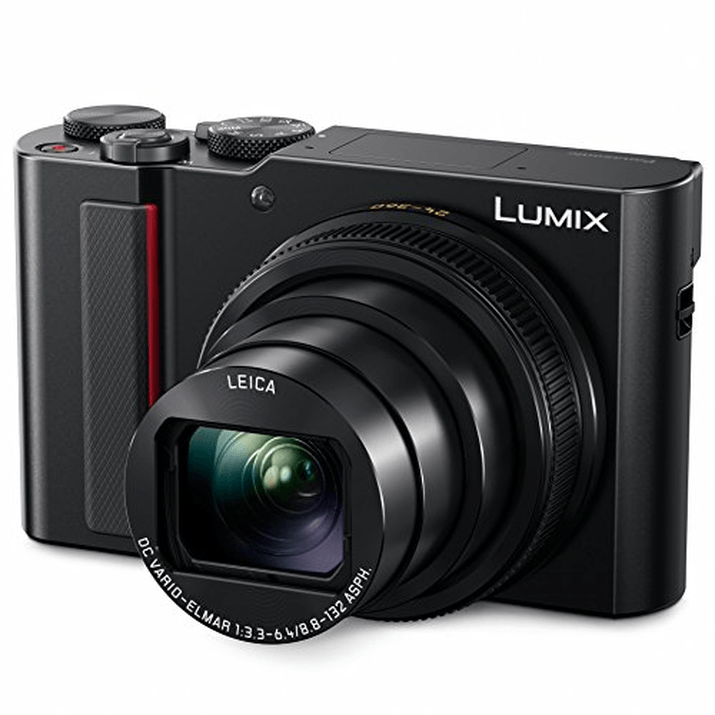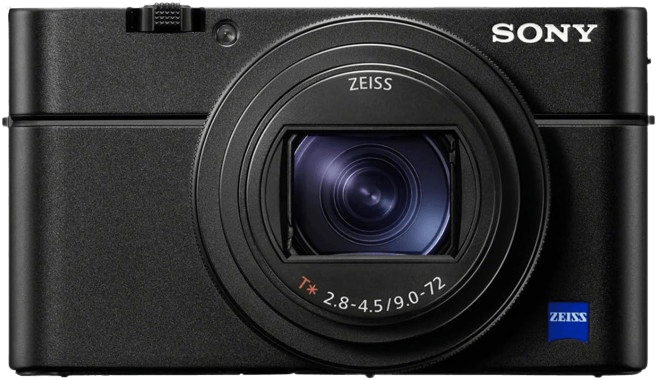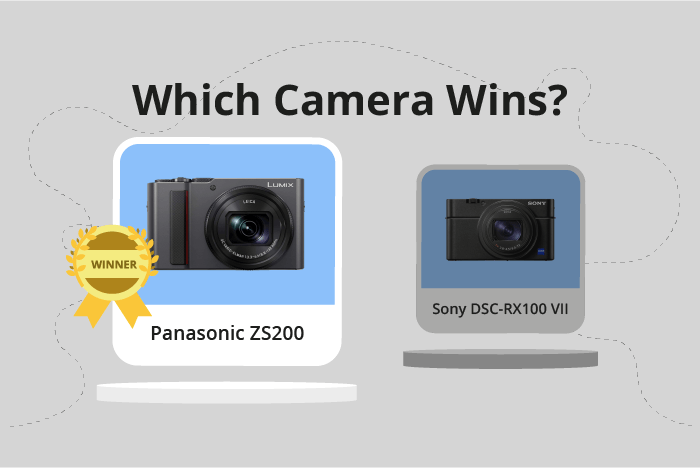Panasonic Lumix ZS200 (TZ200) vs Sony Cyber-shot DSC-RX100 VII Comparison
Panasonic Lumix ZS200 / TZ200

Sony RX100 VII

The Panasonic Lumix ZS200 (TZ200) edges out the Sony Cyber-shot DSC-RX100 VII with a score of 62/100 compared to Sony’s 60/100. Both compact cameras share similarities, such as their release years (2018 and 2019) and launch prices ($799 and $1200, respectively).
The Lumix ZS200 has a slight advantage in size and weight, measuring 111 x 66 x 45mm and weighing 340g (0.75lbs), making it a bit more substantial than the Sony RX100 VII at 102 x 58 x 43mm and 302g (0.67lbs). This added heft may contribute to a better grip and stability when shooting.
On the other hand, the Sony RX100 VII is more compact and lightweight, making it a more portable option for those who prioritize portability. The difference in scores between these two cameras is minimal, so choosing the best option would depend on the user’s specific needs and preferences.
Panasonic Lumix ZS200 (TZ200) vs Sony Cyber-shot DSC-RX100 VII Overview and Optics
The Panasonic Lumix ZS200 (TZ200) and the Sony Cyber-shot DSC-RX100 VII have identical scores for optics at 61/100. Both cameras share several common specifications, including 20-megapixel resolution, CMOS sensor type, 1″ sensor size, fixed lens mount, and image stabilization.
The Lumix ZS200 outperforms the RX100 VII in shooting speed and DXOMARK score for the sensor. With a shooting speed of 10 frames per second (fps), the ZS200 is twice as fast as the RX100 VII, which has a shooting speed of 5 fps. This means that the ZS200 can capture fast-moving subjects more effectively. Additionally, the ZS200 has a higher DXOMARK score for the sensor at 71, compared to the RX100 VII’s score of 63. This indicates that the ZS200’s sensor performs better in terms of image quality and low-light performance.
On the other hand, the RX100 VII has a more advanced processor, the Bionz X, compared to the ZS200’s Venus Engine. The Bionz X processor allows for faster image processing and better noise reduction, resulting in improved image quality.
In terms of optics, both cameras have their strengths and weaknesses. The Panasonic Lumix ZS200 has a faster shooting speed and a better-performing sensor, making it more suitable for capturing fast-moving subjects and low-light photography. Meanwhile, the Sony Cyber-shot DSC-RX100 VII has a more advanced processor, which results in faster image processing and better noise reduction. Choosing between these cameras depends on the specific needs and preferences of the user.
Panasonic Lumix ZS200 (TZ200) vs Sony Cyber-shot DSC-RX100 VII Video Performance
The Sony Cyber-shot DSC-RX100 VII outperforms the Panasonic Lumix ZS200 (TZ200) in video capabilities, scoring 91/100 compared to the Lumix’s 83/100. Both cameras share common specifications, such as 4K maximum video resolution and 3840 x 2160 maximum video dimensions. They also both have time-lapse functionality built in.
The Sony RX100 VII excels with a maximum video frame rate of 120fps, double the Lumix ZS200’s 60fps. This higher frame rate allows for smoother video playback and the ability to create impressive slow-motion effects. The RX100 VII’s superior video performance is evident in its higher score, making it the better choice for those prioritizing video capabilities.
While the Panasonic Lumix ZS200 may have a lower video score, it is important to consider its strengths. The Lumix ZS200 offers a solid video performance with 4K resolution and time-lapse functionality. For users who do not require the advanced video frame rate of the Sony RX100 VII, the Lumix ZS200 remains a viable option. It is essential to weigh the importance of video frame rate when deciding between these two cameras.
Comparing the video capabilities of the Panasonic Lumix ZS200 and Sony Cyber-shot DSC-RX100 VII, it is clear that the RX100 VII has the advantage with its higher video score and frame rate. However, the Lumix ZS200 remains a strong contender with its 4K resolution and time-lapse features. Ultimately, the choice between these two cameras depends on the user’s specific needs and priorities in video performance.
Panasonic Lumix ZS200 (TZ200) vs Sony Cyber-shot DSC-RX100 VII Features and Benefits
The Panasonic Lumix ZS200 (TZ200) wins the features comparison with a score of 70/100, while the Sony Cyber-shot DSC-RX100 VII scores slightly lower at 68/100. Both cameras share several specifications, such as a 3-inch touchscreen, WiFi, and Bluetooth connectivity. Neither camera has GPS functionality.
The Lumix ZS200 outperforms the RX100 VII in screen resolution, offering 1,240,000 dots compared to the Sony’s 921,000 dots. This higher resolution provides clearer and sharper image previews, making it easier for users to review and edit their photos on the camera itself.
On the other hand, the RX100 VII has a flip screen, which the ZS200 lacks. This feature allows users to take photos from various angles more comfortably and is particularly useful for capturing selfies or recording vlogs. Despite the lower screen resolution, the flip screen gives the RX100 VII an advantage in terms of versatility.
Considering the features of both cameras, the Lumix ZS200’s higher screen resolution contributes to a better user experience when reviewing and editing photos on the camera. However, the RX100 VII’s flip screen provides greater flexibility for users who prioritize capturing images from different angles. Ultimately, the choice between these two cameras will depend on the specific needs and preferences of the user.
Panasonic Lumix ZS200 (TZ200) vs Sony Cyber-shot DSC-RX100 VII Storage and Battery
The Panasonic Lumix ZS200 (TZ200) wins the storage and battery comparison with a score of 35/100, while the Sony Cyber-shot DSC-RX100 VII scores 29/100. Both cameras have one memory card slot and accept SD/SDHC/SDXC cards. The Lumix ZS200 is also UHS-I compatible, while the RX100 VII additionally accepts Memory Stick Pro Duo cards.
The Lumix ZS200 surpasses the RX100 VII in battery life, offering 370 shots compared to the RX100 VII’s 260 shots. This longer battery life is due to the ZS200’s DMW-BLG10 battery type. Both cameras, however, support USB charging.
Although the RX100 VII has a lower score, it has the advantage of accepting Memory Stick Pro Duo cards, providing more storage options for users. Nonetheless, the Lumix ZS200’s longer battery life and UHS-I compatibility make it the superior choice for storage and battery performance.
Panasonic Lumix ZS200 (TZ200) vs Sony Cyber-shot DSC-RX100 VII – Our Verdict
Are you still undecided about which camera is right for you? Have a look at these popular comparisons that feature the Panasonic Lumix ZS200 (TZ200) or the Sony Cyber-shot DSC-RX100 VII:
- Ricoh GR IIIx vs Sony Cyber-shot DSC-RX100 VII
- Panasonic Lumix DMC ZS100 vs Lumix ZS200 (TZ200)
- Canon PowerShot G7 X Mark III vs Sony Cyber-shot DSC-RX100 VII
- Canon PowerShot G5 X Mark II vs Sony Cyber-shot DSC-RX100 VII
- Canon PowerShot G7 X Mark III vs Panasonic Lumix ZS200 (TZ200)
- Canon PowerShot G1 X Mark III vs Sony Cyber-shot DSC-RX100 VII

